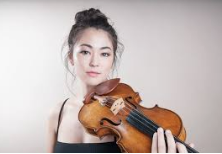|
Symphony
MYSTICAL PLANETS AND LIVELY GERSHWIN ORTIZ AT FINAL SRS CONCERT
by Peter Lert
Sunday, May 4, 2025
Symphony
VSO'S CONCERT MUSIC OF TIME, MUSIC OF PLACE
by Peter Lert
Sunday, April 27, 2025
Choral and Vocal
VOCAL ELEGANCE AND FIRE AT THE 222'S RECITAL APRIL 26
by Pamela Hicks Gailey
Saturday, April 26, 2025
CANTIAMO SONOMA SINGS AN INSPIRED GOOD FRIDAY MOZART REQUIEM CONCERT
by Pamela Hicks Gailey
Friday, April 18, 2025
DRAMATIC SHOSTAKOVICH SYMPHONY CLOSES PHILHARMONIC'S 25TH SEASON
by Terry McNeill
Sunday, April 13, 2025
LARGE COLLEGE OF MARIN AUDIENCE GREETS STOPHER ARTISTRY
by Terry McNeill
Saturday, April 5, 2025
Chamber
FRISSON DELIVERS SHIVERS OF DELIGHT
by Abby Wasserman
Sunday, March 30, 2025
OLD AND MOSTLY NEW IN SRS MARCH CONCERT IN WEILL
by Peter Lert
Saturday, March 22, 2025
Symphony
TWO FORMIDABLE SYMPHONIES AND PURPLE MOUNTAINS AT SRS CONCERT
by Peter Lert
Sunday, February 23, 2025
Chamber
THE PARKER CAPTURES DEMANDING ADES QUARTET AT RAC SEBASTOPOL CONCERT
by Peter Lert
Saturday, February 15, 2025
|
 |
 Simone Porter |
SIMONE PORTER ASPIRES TO STARDOM WITH SANTA ROSA SYMPHONY
by Steve Osborn
Sunday, January 12, 2020
The Sibelius violin concerto is one of several mountains that violin soloists need to ascend before they can lay claim to stardom. Hundreds make the attempt every year, but only a few reach the top. Simone Porter, who played the concerto with the Santa Rosa Symphony on Sunday afternoon, got close but didnít quite summit.
Ms. Porter wore a red jumpsuit that complemented her athleticism and musicality. She was often in motion, whether bending at the knees to gather strength or bolting upright to reach the highest notes on her instrument. Her movements often paralleled her phrasing, with forward surges or backward steps marking phrase beginnings and endings.
The main story, however, was Ms. Porterís gorgeous sound, particularly on the lower strings. Her low notes at the beginning of the concertoís first movement were simply stupendous. She could have stayed down there for the entire concerto, so awesome was the sound.
Nonetheless, Ms. Porter moved on to the upper strings, complementing her basso profundo with exquisite phrasing somewhere north of high C. It was a visceral performance aided and abetted by flawless bowing and vibrato. Her bow arm was a marvel of fluidity. The highlight of the first movement was a ďsul GĒ passage near the end that the violinist played entirely on the G string while effortlessly shifting up and down the fingerboard. The closing presto was nearly as riveting, and the audience, including me, burst into indecorous applause at the end.
Sadly, the slow second movement didnít live up to the sprightly first. The horn entries were sometimes ragged, and the orchestra was often too loud, covering Horner to a certain degree. Worse still, the tempo began to plod in the middle, but both Horner and conductor Francesco Lecce-Chong made a full recovery in time for the emotional ending.
The third movement was a mixed bag. Ms. Porter played the main theme beautifully, really digging in to the repeated downbows that punctuate the movement. But her many upper-register runs were sometimes rough, with dubious intonation on the highest notes and a lack of clarity in the fastest passages. The beauty and urgency of her playing, however, brought her close to the top. Stardom is a definite possibility after some fine tuning.
Sticking with the tried and true, Mr. Lecce-Chong conducted Brahmsí second symphony after intermission. Instead of a red-clad soloist, attention shifted to the orchestra itself, where full participation is needed to unveil Brahmsí intricate and monumental construction. The strings began with assurance, producing a lush but crisp sound in the opening bars. The conductor's gestures on the podium were compact and exact, displaying a lapidary polish and precision. One could close oneís eyes and imagine a bucolic alpine meadow, surrounded by imposing mountains.
The cellos opened the second movement with an expansive line that warmly embraced a limpid solo by horn principal Meredith Brown. Suddenly, everything was moving at once, with each line distinct and easily heard. Mr. Lecce-Chong achieved clarity amid Brahmsí density, allowing each section its moment in the sun. A wonderful pause near the end actually increased the dramatic intensity.
The exactitude and precision continued in the remaining movements. In the third, the dynamics were superb, the melodies playful and lilting. In contrast, the fourth was rollicking and tumultuous, with a staggering level of artistic invention on display. Mr. Lecce-Chong captured just the right spirit by eschewing overly dramatic gestures and keeping to the task at hand. Itís hard to imagine a better performance.
Embarrassingly, I was a few minutes late to the concert because of a forgotten ticket, so I had to watch the opening pieceóMissy Mazzoliís Sinfoniaóon a closed-circuit TV in the lobby. It sounded interesting, but thatís as far as I can go.
Reprinted with permission from San Francisco Classical Voice
|
